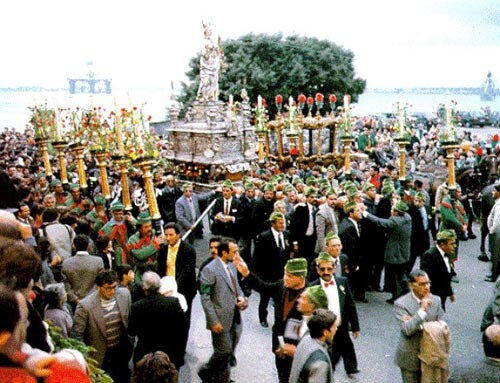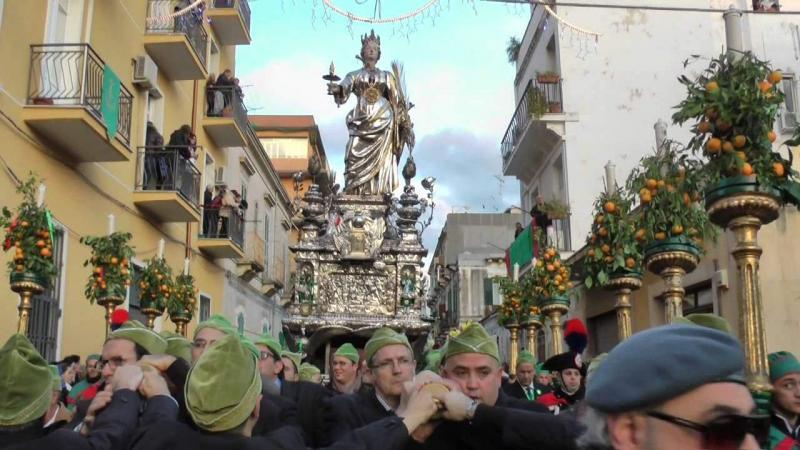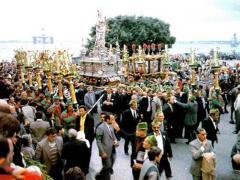Feast of Santa Lucia - Syracuse
La feast of Saint Lucia takes place 13 and 20th December a SIRACUSA where the virgin e martyr Saint Lucia was born.
It is a very heartfelt and participatory party that conveys to the city Sicilian an enormous amount of faithful from all over the province and a good part of the Eastern Sicily.
The patronal feast of the Syracusan saint, although it is preceded by a preparation consisting of moments of prayers and other purely religious initiatives that begins 13 days earlier (this preparation is called "thirteen"), officially begins in the cathedral about five days earlier with the opening of the niche that houses the simulacrum. On the morning of December 12, however, the silvery simulacrum is translated to the cry of "Sarausana jè "(Syracusan is) from his "room" to the high altar. In the evening, the solemn vespers presided over by the archbishop are then celebrated in the Cathedral, in which various priests of the diocese, deacons, the archbishop's seminary, as well as various civil and religious authorities participate. At the end of Vespers, the "cuccìa ”, a typical Luciano dessert that is traditionally prepared the day before the party.
December 13th: This is the main day of the festival. The silvery simulacrum is carried on the shoulder by 60 green caps (nickname given to the bearers due to the characteristic color of the caps) from about 15:30 pm when, amidst the festive sound of the bells, it is carried from the cathedral onto Piazza Duomo crowded with waiting devotees . The simulacrum is preceded by a vara where the relics of the saint carried on the shoulders by women are located inside valuable exhibitors.
After a brief social speech by the archbishop to citizenship, the procession descends along the Aretusa promenade to cross, in the late afternoon, the "Porta Marina" (adjacent to the Great Port), where one of the most touching moments of the day takes place, that is the greetings of sailors and soldiers who make the sirens of their ships sound festive. After that, the simulacrum of Saint Lucia can go towards the bridge named after her to allow a stop of a few minutes.
When the procession is by now on the mainland, it goes along Corso Umberto where it turns into viale Regina Margherita, thus approaching the heart of the Borgata Santa Lucia going up via Piave until reaching piazza Santa Lucia and the Basilica of Santa Lucia al Sepolcro.
Upon entering the basilica, the simulacrum is placed on the high altar where it will remain in front of the faithful for the next seven days.
Day 20, a day traditionally defined by Syracusans as "the eighth", the simulacrum of Saint Lucia, compared to the journey seven days earlier, observes several stops very much felt by the faithful. The procession has a starting time of 16:00 with departure from the Borgata basilica, and not long after the first stop is scheduled at sanctuary of Our Lady of Tears where the meeting between the saint and Mary takes place around which the community of the Marian temple gathers with its rector who gives a short speech to the citizens.
A few meters from the sanctuary is the umberto I hospital and once the first visit is over, it is here that the procession stops again, witnessing the visit to the sick and participating in the moment of prayer managed by the hospital community.
After this other stop, the procession resumes its journey descending along Corso Gelone and the neighboring streets of the city center, the descent towards the island begins from the top of Corso Umberto, upon reaching the Umbertine bridge (the bridges for Syracusans), the last stop is made to kick off the traditional fireworks display.
Once back on the island of Ortigia from piazza Pancali, the route includes the ascent of corso Matteotti and subsequently a new detour to the very central piazza Archimede and adjacent streets with final destination piazza Duomo. The return to the cathedral is greeted with the final firing of the barrels, and after the ritual operations, the silver simulacrum is stored in the niche where it remains closed until the first Sunday in May, when the feast of Saint Lucia king quagghie.
Source: Wikipedia
----------------
Technical sheet prepared by: Region of Sicily - Department of cultural heritage and Sicilian identity - CRicd: Regional center for inventory, cataloging and documentation and Sicilian regional film library














